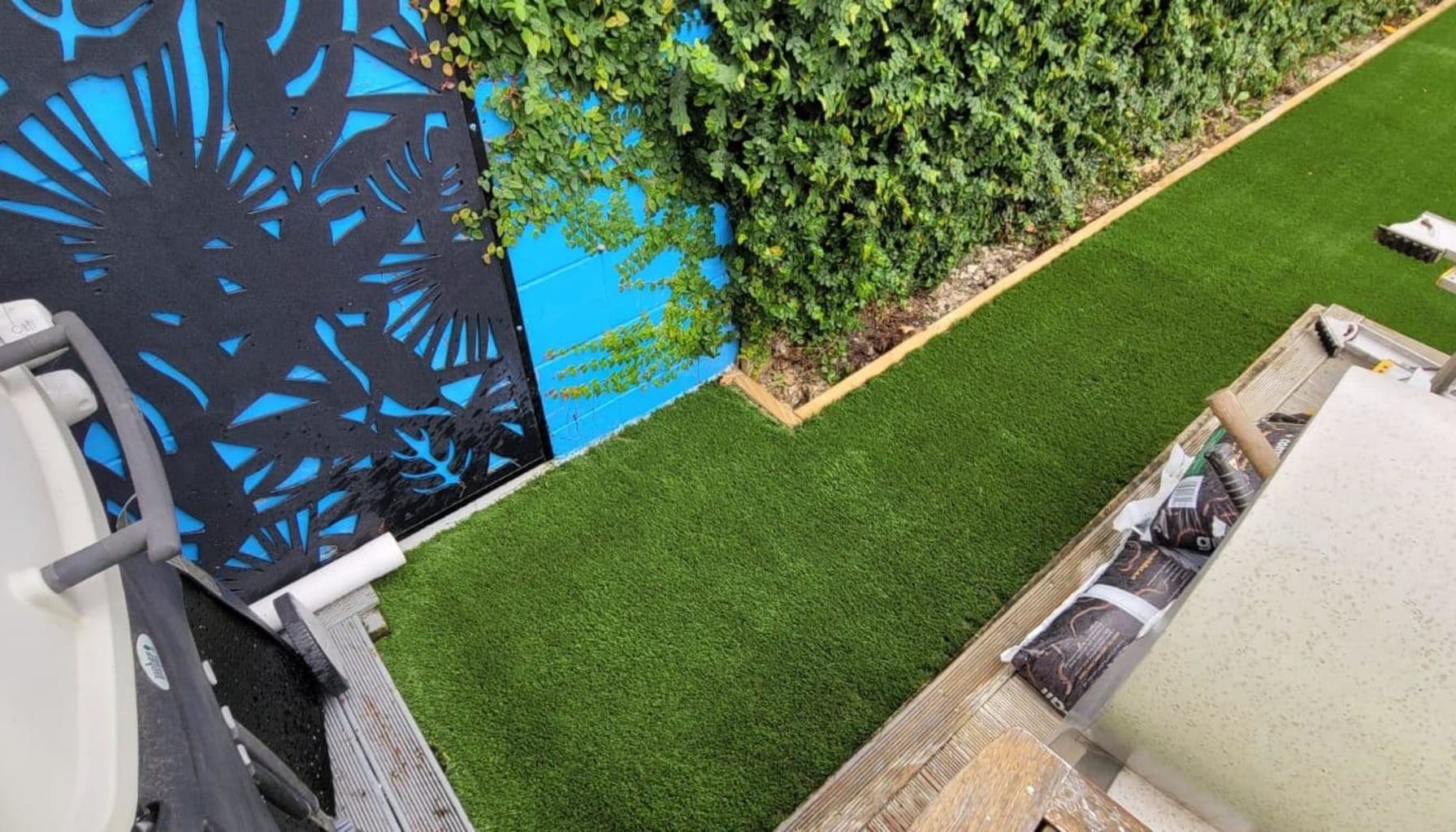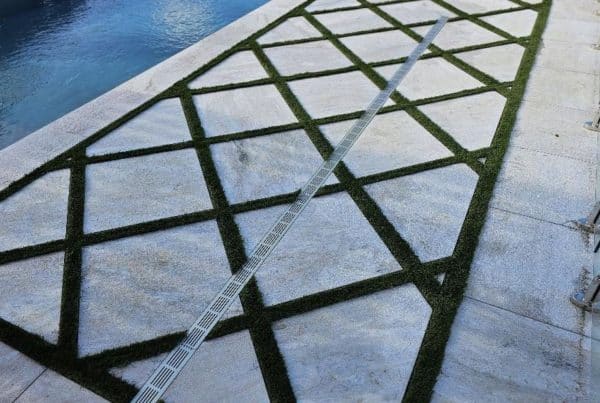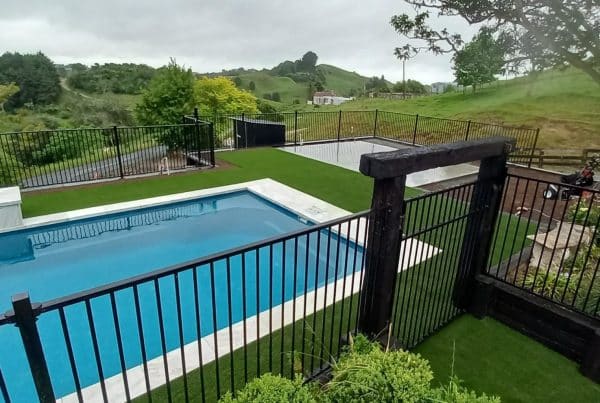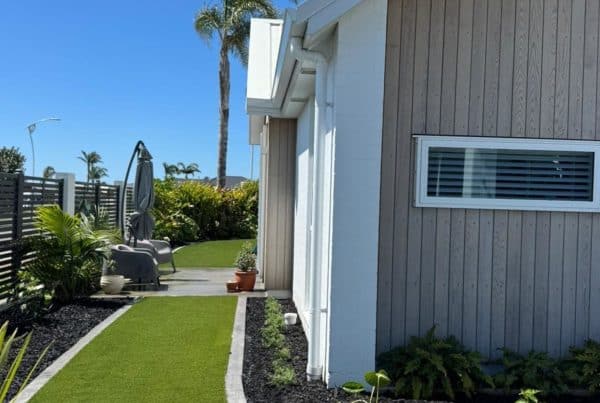At Unreal Lawns & Courts, we know that synthetic turf cost is a top concern for many property owners considering an artificial lawn.
Understanding the factors that influence pricing can help you make an informed decision about this investment. In this post, we’ll break down the key elements affecting synthetic turf expenses and compare them to natural grass costs.
We’ll also explore the long-term benefits that can offset the initial outlay, giving you a clear picture of the value synthetic turf can bring to your property.
What Drives Synthetic Turf Costs?
Synthetic turf costs vary widely, influenced by several key factors. Prices range from NZD $30 to $60 per square metre for high-quality products. This price difference stems from multiple variables that affect the final cost of your artificial lawn project.
Quality and Material Choices
The type and quality of artificial grass significantly impact the overall cost. Polypropylene (PP) artificial grass is a more cost-effective option compared to other types. High-end options made from nylon fibres provide superior strength but come at a premium price. For optimal performance in residential settings, a minimum face weight of 60 ounces per square yard is recommended.
Project Size and Complexity
The size of your installation area directly affects the total cost. Larger areas often benefit from economies of scale, potentially reducing the per-square-metre price. However, complex layouts with curves, slopes, or obstacles can increase labour costs and material waste.
Site Preparation Requirements
Proper site preparation is essential for a long-lasting synthetic turf installation. This process involves the removal of existing grass, ground levelling, and drainage assurance. The condition of your current landscape determines the extent of preparation needed. In some cases, additional work like soil remediation or drainage system installation may be necessary, adding to the overall cost.
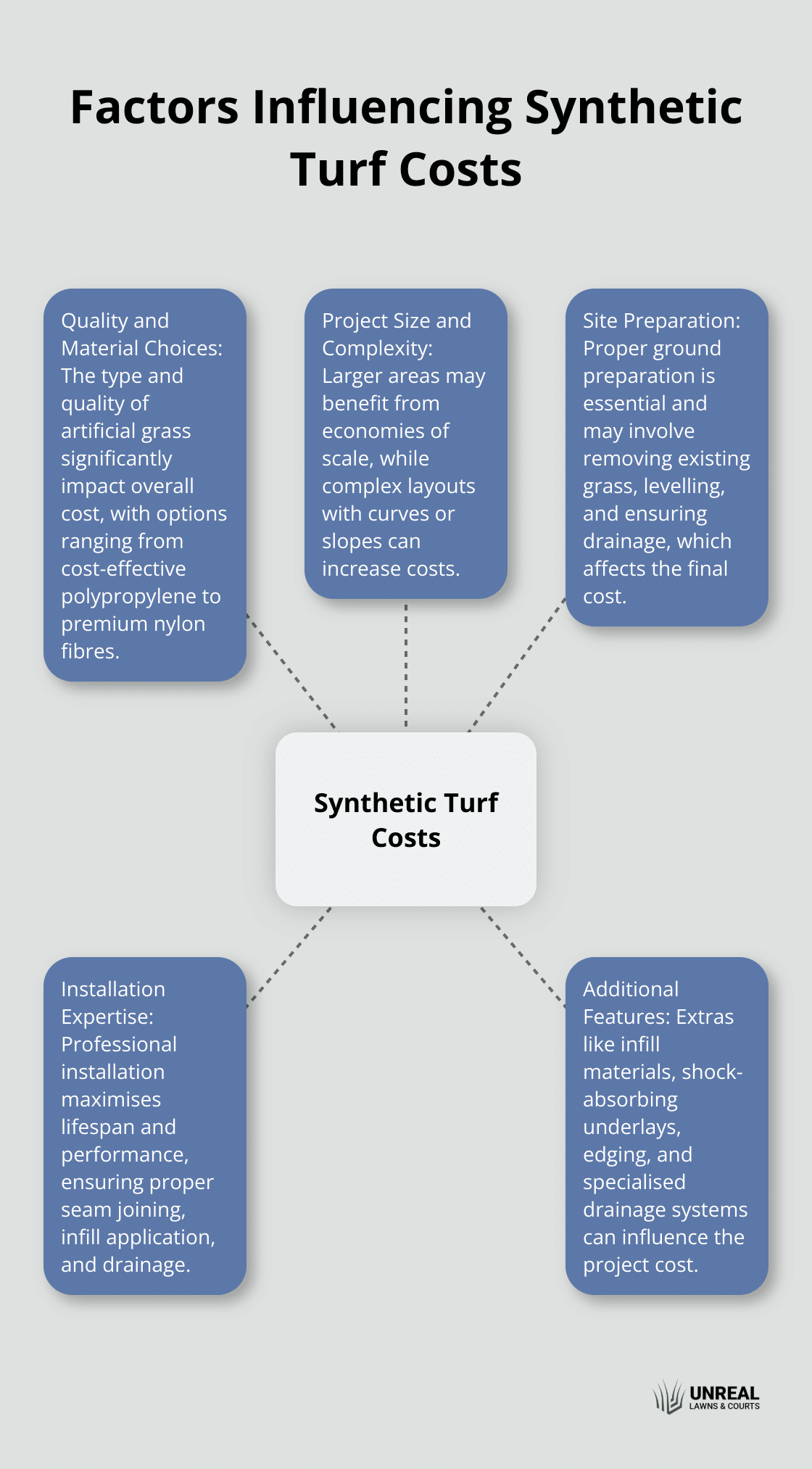
Installation Expertise
Professional installation maximises the lifespan and performance of your synthetic turf. While DIY installation might seem tempting to save money, it often leads to issues like uneven surfaces or poor drainage (which can be costly to fix later). Professional installers ensure proper seam joining, infill application, and drainage – critical factors for the longevity of your artificial lawn.
Additional Features and Accessories
The inclusion of extra features can further influence the cost of your synthetic turf project. These may include:
- Infill materials (such as sand or rubber granules)
- Shock-absorbing underlays (particularly important for sports applications)
- Edging and border materials
- Specialised drainage systems
While these additions increase the initial investment, they often enhance the performance and durability of your synthetic turf, potentially leading to long-term savings.
As we move forward, it’s important to consider how these costs compare to maintaining a natural grass lawn. The next section will explore this comparison in detail, helping you make an informed decision about your landscaping investment.
Is Synthetic Turf More Cost-Effective Than Natural Grass?
Initial Installation Costs
The upfront cost of synthetic turf appears higher than natural grass. Industry data shows that artificial grass in New Zealand costs between NZD $30 to $60 per square metre, with total installation costs reaching up to NZD $150 per square metre. Natural grass installation, however, comes at a lower initial price of $28.48 per square metre. This price difference might deter some property owners at first glance, but a deeper analysis reveals a different story.
Long-Term Maintenance Savings
Synthetic turf shines when it comes to long-term maintenance expenses. Natural grass demands regular mowing, watering, fertilising, and occasional re-seeding or re-sodding. These ongoing costs accumulate significantly over time.
In contrast, synthetic turf requires minimal upkeep. Property owners eliminate the need for mowing, watering, or fertilising. This translates to substantial savings on equipment, water bills, and lawn care products. Homeowners can save hundreds or even thousands of dollars annually on lawn care products alone by opting for artificial grass.
Water Conservation and Environmental Impact
Water usage plays a critical role in the cost comparison between synthetic and natural turf. A synthetic turf installation saves thousands of litres of water annually for a 100 square meters lawn. This water conservation not only reduces utility bills but also supports environmental sustainability goals.
Furthermore, synthetic turf eliminates the use of chemical fertilisers and pesticides, which reduces potential environmental harm and associated costs. The absence of gas-powered lawn equipment also contributes to lower carbon emissions from lawn maintenance.
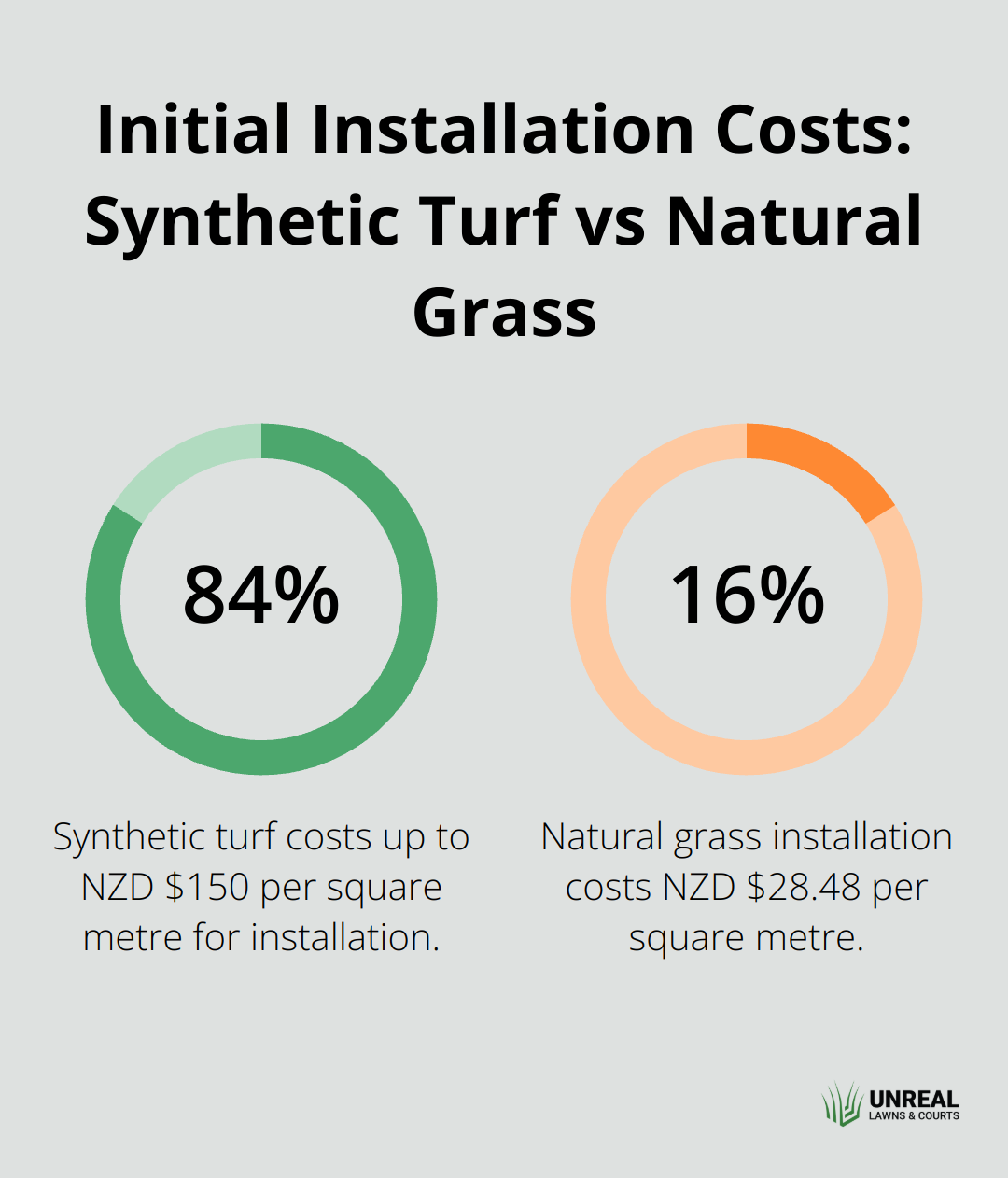
Durability and Lifespan
The longevity of synthetic turf further enhances its cost-effectiveness. A good quality artificial grass that is properly installed and maintained can last up to 20 years or more. This extended lifespan means fewer replacements compared to natural grass, which may require re-seeding or re-sodding every few years (especially in high-traffic areas).
While the upfront cost of synthetic turf is higher, its durability and low maintenance requirements often result in it paying for itself over time. The exact break-even point varies depending on factors such as local water costs, climate conditions, and the specific products used.
The cost-effectiveness of synthetic turf versus natural grass extends beyond the initial price tag. Long-term maintenance, water savings, and durability all contribute to the economic advantages of artificial grass. These benefits lead us to explore the specific cost-saving aspects of synthetic turf in more detail.
How Synthetic Turf Saves Money
Reduced Water Consumption
Synthetic turf significantly cuts water usage. Natural lawns demand frequent watering, particularly during dry periods. Artificial grass, however, maintains its lush appearance without any watering. A University of California study reveals that artificial turf can save up to 2241 litres of water per square meter annually. This results in substantial reductions in water bills, especially in drought-prone areas or regions with high water costs.
Elimination of Ongoing Maintenance Costs
Natural grass upkeep involves numerous expenses that quickly accumulate. Synthetic turf removes these costs entirely. Property owners no longer need mowers, trimmers, or fuel. Fertilisers, pesticides, and weed control products become obsolete. Synthetic turf significantly reduces maintenance time and costs. A comparison between artificial turf and natural grass examines six major factors, including maintenance requirements.
Enhanced Longevity and Durability
High-quality synthetic turf lasts 15 to 20 years or longer with proper care. This extended lifespan means fewer replacements compared to natural grass, which often requires re-sodding or extensive repairs every few years (especially in high-traffic areas). The durability of synthetic turf makes it ideal for heavily used spaces, such as sports fields or commercial areas, where natural grass struggles to recover.
Increased Property Value
While not a direct cost-saving measure, synthetic turf can boost property value. A well-maintained, lush lawn enhances kerb appeal and attracts potential buyers. The National Association of Realtors indicates that a landscaping investment (which includes high-quality turf) can yield a return on investment of up to 100% when selling a property. This added value, combined with ongoing savings in maintenance and water costs, makes synthetic turf an attractive option for homeowners who want to improve their property’s worth.
Final Thoughts
Synthetic turf cost encompasses various factors, from material quality to installation complexity. The initial investment may seem substantial, but the long-term benefits often outweigh the upfront expenses. High-quality artificial grass offers durability, minimal maintenance, and significant water savings, which contribute to reduced utility bills and environmental conservation.
The value of synthetic turf extends beyond mere cost savings. It provides a consistently attractive landscape that enhances property aesthetics and potentially increases real estate value. For busy homeowners or commercial property managers, the time saved on lawn care translates to improved quality of life or operational efficiency.
Professional installation plays a vital role in realising these benefits. Unreal Lawns & Courts offers premium artificial grass solutions tailored to New Zealand’s unique climate and lifestyle needs. Our team combines top-quality materials with expert installation to deliver durable, low-maintenance synthetic turf (that stays lush year-round).

